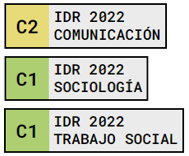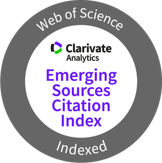Connecting influencers with Gen Z in the makeup industry
Keywords:
Marketing de influencia; Influencer; Maquillaje; Marca; Publicidad; Redes Sociales., Influence Marketing; Influence; Makeup; Brand; Advertising; Social media.Abstract
The birth of the Internet is considered one of the most important revolutionary events in the history of humanity, but this phenomenon was not cemented until the appearance of social networks that completely changed the way of relating. In this way, consumption, advertising and the general vision of makeup have been transformed with the birth of various digital platforms. Brands no longer only focus on communicating the benefits of their products to sell, now a link with the consumer is needed, a closeness and credibility through the figure of the influencer, who was born to connect with younger audiences and establish connections strong towards the brand. Through a sample of 1071 people belonging to the interest group of generation Z, they have given the results that the platforms most used by young consumers are the most visual and dynamic, such as Instagram with 53.5%, followed by YouTube. It is also discovered that Tik Tok is beginning to gain ground among the generation Z sector of the population and that Facebook is losing prominence, being the least chosen by young people.
Downloads
References
Caldevilla Domínguez, D. (2010). Las Redes Sociales. Tipología, uso y consumo de las redes 2.0 en la sociedad digital actual. Documentación de las Ciencias de la Información, 33, 45-68.
Campoverde, J. (2018). Generación Y y Z. Atlante Cuadernos de Educación y Desarrollo, marzo. https://www.eumed.net/rev/atlante/2018/03/estudio-generacionyz.html
Carbellido Monzó, C. (2020). Marketing de Influencers: ¿Qué es y cómo planificar una campaña eficaz? Un community manager. https://www.uncommunitymanager.es/marketing-influencers/
Castello-Martinez, A., & Pino Romero, C. del. (2015). Prescriptores, marcas y tuits: El marketing de influencia. http://hdl.handle.net/10045/48350
Del-Pino-Romero, C. (2011). Redes sociales, comunicación publicitaria y usuario digital en la nueva era. Comunicación: revista Internacional de Comunicación Audiovisual, Publicidad y Estudios Culturales, 9, 163-174.
Fernández de la Iglesia, J. C., Casal Otero, L., Fernández Morante, M. C., & Cebreiro, B. (2020). Actitudes y uso de Internet y redes sociales en estudiantes universitarios/as de Galicia: Implicaciones personales y sociales. Revista Prisma Social, 28, 145-160.
Fernández Lerma, A. (2017). Estudio del origen de la figura del influencer y análisis de su poder de influencia en base a sus comunidades [Trabajo Fin de Grado, Universidad Pompeu Fabra]. https://repositori.upf.edu/bitstream/handle/10230/36313/Fernandez_2017.pdf?sequence=1&isAllowed=y
Gómez de Travesedo Rojas, R., & Gil Ramírez, M. (2020). Generación Z y consumo de información política: Entre la televisión y los nuevos formatos mediáticos. Ámbitos. Revista Internacional de Comunicación, 50, 62-79. https://doi.org/10.12795/Ambitos.2020.i50.05
Hatch Dorantes, H. (2012, julio 27). Influenciadores ¿Quiénes son realmente? - Revista Merca2.0. https://www.merca20.com/influenciadores-quienes-son-realmente/
IAB Spain. (2018). Estudio Anual de Redes Sociales 2018. https://iabspain.es/estudio/estudio-anual-de-redes-sociales-2018/
IAB Spain. (2019). Estudio Anual de Redes Sociales 2019. https://iabspain.es/estudio/estudio-anual-de-redes-sociales-2019/
IAB Spain. (2020). Estudio Anual de Redes Sociales 2020. https://iabspain.es/estudio/estudio-anual-de-redes-sociales-2020/
InboundCycle. (2017). ¿Qué es un influencer? Definición y utilidad en tu estrategia de marketing. https://www.inboundcycle.com/diccionario-marketing-online/que-es-un-influencer
Influenster. (2020). Top-Rated Huda Beauty Products: 102K Reviews | Influenster Reviews 2021. https://www.influenster.com/article/top-rated-huda-beauty-products
Informe Mediakix (2020). The Influencer Marketing Industry Global Ad Spend: A $5-$10 Billion Market By 2020 [CHART]. https://mediakix.com/blog/influencer-marketing-industry-ad-spend-chart/
Launchmetrics (2020). La estrategia en Instagram de las principales marcas de cosmética. https://www.launchmetrics.com/es/recursos/blog/estrategia-instagram-marcas-cosmetica
López-de-Ayala, M.-C., Vizcaíno-Laorga, R., & Montes-Vozmediano, M. (2020). Hábitos y actitudes de los jóvenes ante las redes sociales: Influencia del sexo, edad y clase social. El profesional de la información, e290604. https://doi.org/10.3145/epi.2020.nov.04
Marca Sephora (2020). Fenty Beauty Hub Page. https://www.sephora.es/FENTY-HubPage.html
Marca Shisheido (2020). Sobre nosotros | SHISEIDO. https://www.shiseido.com/us/es/about-the-shiseido-brand.html
Romero, C. (2011). Redes sociales, comunicación publicitaria y usuario digital en la nueva era. Revista de Comunicación Universidad Carlos III, 1(9), 163-174.
Sánchez Herrera. J. y Pintado Blanco, T. (2010). Nuevas tendencias en comunicación. Editorial Esic Madrid.
Sicilia, M., López, I., Palazón, M. y López, M. (2021). Márketing en Redes Sociales. Editorial Esic Madrid.
Upinfluence. (2020). The State of Influencer Marketing in the Beauty Industry. https://www.upfluence.com/industry-reports/beauty
Villarejo, A. (2014, mayo 26). Influencers: ¿por qué son importantes en tu estrategia de redes sociales? 40deFiebre. https://www.40defiebre.com/influencers-importantes-estrategia-social-media
Downloads
Published
How to Cite
Issue
Section
License
Copyright (c) 2021 Revista Prisma Social

This work is licensed under a Creative Commons Attribution-NonCommercial-NoDerivatives 4.0 International License.
Those authors who publish in this journal accept the following terms:
-
Authors retain copyright.
-
Authors transfer to the journal the right of first publication. The journal also owns the publishing rights.
-
All published contents are governed by an Attribution-NoDerivatives 4.0 International License.
Access the informative version and legal text of the license. By virtue of this, third parties are allowed to use what is published as long as they mention the authorship of the work and the first publication in this journal. If you transform the material, you may not distribute the modified work. -
Authors may make other independent and additional contractual arrangements for non-exclusive distribution of the version of the article published in this journal (e.g., inclusion in an institutional repository or publication in a book) as long as they clearly indicate that the work was first published in this journal.
- Authors are allowed and recommended to publish their work on the Internet (for example on institutional and personal websites), following the publication of, and referencing the journal, as this could lead to constructive exchanges and a more extensive and quick circulation of published works (see The Effect of Open Access).


















